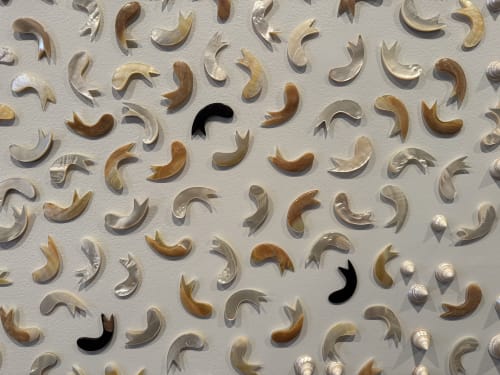“Traditionally, we carve mother of pearl, ebony, trochus, turtle shell and dugong bone,” says Darrell Sibosado.
Niman Aarl is the second configuration of a large-scale installation created on Bard Country by uncle and nephews, Darrell, DJ and Eric Sibosado. It features over 500 hand-carved fish made from mother of pearl, trochus, ebony and turtle shell, materials used by their ancestors for generations.
This configuration nods to the Makassans, who traded pearl shell but mainly visited the Kimberley for trochus and trepang. Contact was limited, but from stories Darrell knows, it could have been more significant, as the Makassans would have been fishing and eating from the reef.
The installation invites viewers to reflect on their impact on the environment and what happens below the surface. Inspired by how surface ripples reveal hidden movement beneath the ocean, Niman Aarl speaks to the unseen effects of human interference with natural systems.
Darrell says, “I saw a fish in the trochus shell. It didn’t need to be made, it was already there. So we made more. A whole school. Niman Aarl.”
Darrell’s practice brings together traditional Bard pearl shell carving with contemporary expression. DJ and Eric, young artists learning under both Darrell and Garry Sibosado, continue this cultural legacy by mastering the skills, stories and knowledge tied to these materials. Their home, the community of Lombadina on the Dampier Peninsula, is surrounded by vivid red earth, white beaches and pristine waters. The coastline and sea remain central to Bard life and art, shaping culture, food and story.

